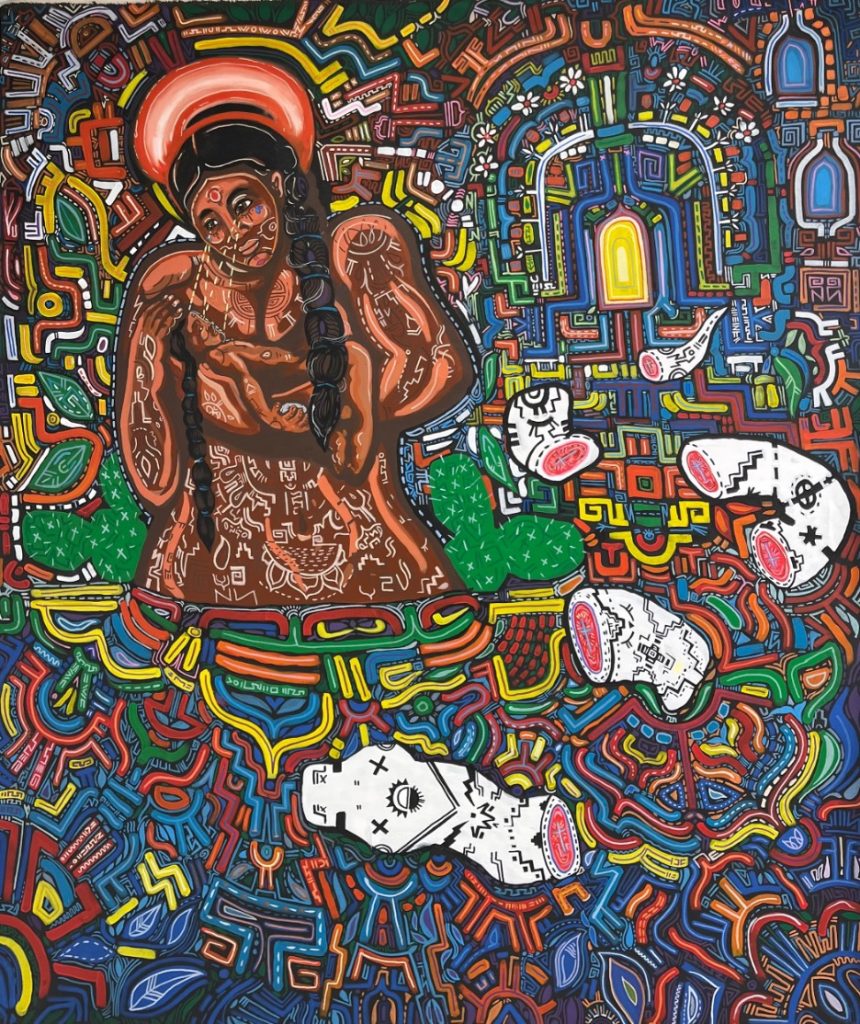by Lori Bowen
Chico Sierra’s “The Good Sun” is set up at the Dedo Maranville gallery from February 13th to April 4th and features a wide selection of Sierra’s works. The show opened alongside a workshop from Sierra himself in which he painted the exhibition’s largest piece for an audience of students and other onlookers. A visiting artist to Valdosta, Chico Sierra originally hails from El Paso but resides currently in Kansas City.[1] With works focusing on topics such as cultural identity and the current political climate, Sierra’s Mexican and Indigenous roots are extremely present in his artistry.[2] This contributes to several motifs present throughout the gallery’s works, alluding to a larger overarching theme of cultural strength in the face of colonization.
While many of Sierra’s works are very large, the gallery arrangement provides the viewer some breathing room with the presentation of his smaller, more abstract works such as Magnified Particle #1 and Magnified Particle #2 among his more representational pieces. His demonstration piece, Slow Collisions, is the largest in the room and takes immediate visual precedence upon entrance. As the gallery is traversed, one of his video pieces plays in the back corner, creating an auditory background of his poetry as the viewer experiences his visual work.

Sierra’s pattern and decoration pays homage to Mayan art, often utilizing collections of small colorful lines and shapes to form a larger subject or composition. His colors are a similar case, bringing to mind both Mayan and Mexican history. Sierra’s white snakes are used in both The Revolution of Inheritance and Sisters of Common Threads, both dead. The snake in the former is divided into five pieces, crosses present in the cross-sections of its body alluding to the snake’s biblical association with the devil. The rest of the piece’s content aligns with this association with its depiction of church-like architecture alongside a woman and child posed not unlike many well-known images of Mary and infant Jesus. The greater significance in this piece is that the woman and her child appear to be of Hispanic descent – a subversion of the usual, white-dominated narrative. The snake’s color and state then become a representation of the death of that narrative as well – in both pieces the white colonizer is killed, and in the former it is revealed that Christianity is at its core.

Chico Sierra’s depiction of femininity is another noteworthy trait of the show, with nearly all of the present works featuring women. Rather than presenting them in any manner of objectification or appropriation, however, Sierra renders them each with a halo behind their heads, lifting them up to a status of holiness and respect. Also among the show’s motifs is plant life, leaves being present in the linework filling the spaces of his canvases and numerous cacti depicted in many of his pieces. The cacti in particular serve as another nod to Mexico, but in the context of the show’s themes their resilience can be interpreted as a reference to the perseverance of cultural identity in the face of colonialism. It’s these associations that make Sierra’s work impactful and encourage the show’s viewer to take a deeper look into the real-world issues he incorporates into his pieces.
[1] “Chico Sierra,” CHICO SIERRA, Accessed March 13, 2025.
[2] Judith Fertig, “Artist Chico Sierra Answers Four Questions,” IN Kansas City Magazine, March 29, 2024.